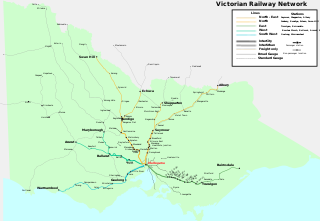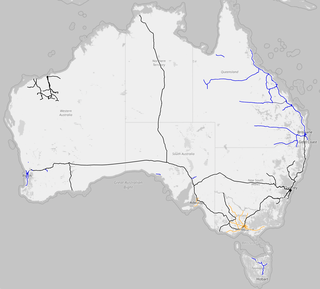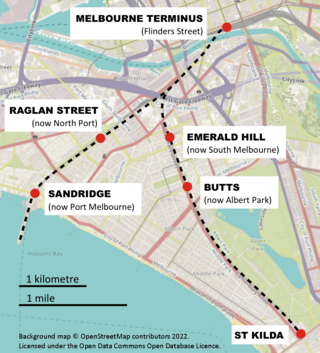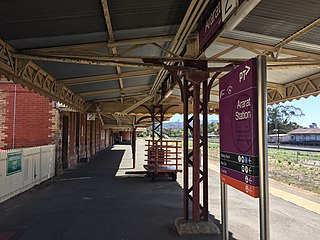
Brighton Beach railway station is a commuter railway station, located on the Sandringham line in Victoria, Australia. It serves the south-eastern Melbourne suburb of Brighton, opened on 21 September 1861 as Beach, and renamed Brighton Beach on 1 January 1867. The station building is listed on the Victorian Heritage Register, noted for its unusual shape and proximity to the coastline. The Brighton Bathing Boxes are located a short walk from the station.

St Kilda station is a current tram stop and former railway station, located in the Melbourne suburb of St Kilda, Australia, and was the terminus of the St Kilda railway line in the Melbourne suburban rail system. It is one of the oldest surviving railway station buildings in Victoria. The building is currently used as retail premises, while the platform serves as stop 132 on tram route 96.

The Sandringham line is a commuter railway line in the city of Melbourne, Victoria, Australia. Operated by Metro Trains Melbourne, it is the city's fourth shortest metropolitan railway line at 17.9 kilometres (11.1 mi). The line runs from Flinders Street station in central Melbourne to Sandringham station in the south-east, serving 14 stations via South Yarra, Balaclava, Elsternwick, and Brighton. The line operates for approximately 20 hours a day with 24 hour service available on Friday and Saturday nights. During peak hour, headways of up to 5 to 10 minutes are operated with services every 10–20 minutes during off-peak hours. Trains on the Sandringham line run with a two three-car formations of Siemens Nexas train sets.

Melbourne tram route 96 is operated by Yarra Trams on the Melbourne tram network from Brunswick East to St Kilda Beach. The 13.9 kilometre route is operated out of Southbank depot with C2 and E class trams.

Melbourne tram route 109 is operated by Yarra Trams on the Melbourne tram network from Box Hill to Port Melbourne. The 19.3 kilometre route is operated out of Kew depot with A and C class trams. It was popularised in the hit song 'The Summer of the 109' by star-studded Facebook comedy influencer Rompa Stompaz.

Rail transport in the Australian state of Victoria is provided by a number of railway operators who operate over the government-owned railway lines. The network consists of 2,357 km of Victorian broad gauge lines, and 1,912 km of standard gauge freight and interstate lines; the latter increasing with gauge conversion of the former. Historically, a few experimental 762 mm gauge lines were built, along with various private logging, mining and industrial railways. The rail network radiates from the state capital, Melbourne, with main interstate links to Sydney and to Adelaide, as well as major lines running to regional centres, upgraded as part of the Regional Fast Rail project.

The Sandridge Bridge is a historic bridge, originally carrying a railway, over the Yarra River in Melbourne, Victoria, Australia. It runs diagonally to the river's banks and is 178.4 metres (585 ft) long. In 2006 it was redeveloped as a pedestrian and cycle path featuring public art. It is the third bridge on the site and is listed on the Victorian Heritage Register.

The Victorian Railways (VR), trading from 1974 as VicRail, was the state-owned operator of most rail transport in the Australian state of Victoria from 1859 to 1983. The first railways in Victoria were private companies, but when these companies failed or defaulted, the Victorian Railways was established to take over their operations. Most of the lines operated by the Victorian Railways were of 5 ft 3 in. However, the railways also operated up to five 2 ft 6 in narrow gauge lines between 1898 and 1962, and a 4 ft 8+1⁄2 instandard gauge line between Albury and Melbourne from 1961.

The first railway in colonial South Australia was a line from the port of Goolwa on the River Murray to an ocean harbour at Port Elliot, which first operated in December 1853, before its completion in May 1854.

The Melbourne cable tramway system was a cable car public transport system, which operated between 1885 and 1940 in Melbourne, Victoria, Australia.

Rail gauges in Australia display significant variations, which has presented an extremely difficult problem for rail transport on the Australian continent since the 19th century. As of 2022, there are 11,914 kilometres (7,403 mi) of narrow-gauge railways, 18,007 kilometres (11,189 mi) of standard gauge railways and 2,685 kilometres (1,668 mi) of broad gauge railways. In the 19th century, each of the colonies of Australia adopted their own gauges.

The Melbourne and Hobson's Bay Railway Company was a railway company in Victoria, Australia. The company was incorporated on 20 January 1853 to build the line from Melbourne to the port of Sandridge, now Port Melbourne.
The Port Melbourne railway line is a former railway line in Melbourne, Australia, opened in September 1854, that is now a light rail line. It was instigated by the Melbourne and Hobson's Bay Railway Company to carry passengers arriving in Victoria at Station Pier and to alleviate the high cost of shipping goods using small vessels up the Yarra River to Melbourne. The line's conversion to light rail occurred in 1987; it is now served by tram route 109.

South Melbourne is a light rail station on the former St Kilda railway line, and was located in the Melbourne suburb of South Melbourne, Victoria, Australia. The station was adjacent to the intersection of Ferrars and Dorcas Streets, just minutes from South Melbourne Market. A pair of low-level side platforms, immediately north of the disused station, now serve route 96 trams on the light rail line, with a pedestrian crossing in between.

Middle Park is a light rail station on the former St Kilda railway line, in the Melbourne suburb of Middle Park, on the corner of Canterbury Road and Armstrong Street. A pair of low-level side platforms now serve route 96 trams running on a light rail line. Other nearby light rail stops are at Fraser Street and Wright Street. Those and a number of other stops were added after the line was converted to light rail.

Albert Park is a light rail station on the former St Kilda line, located in the Melbourne suburb of Albert Park, Victoria. The station is located on Ferrars Street just to the north of Albert Road, just minutes walk from the Bob Jane Stadium, current home of the South Melbourne Soccer club and the former home of the South Melbourne Football Club. A pair of low level side platforms now serve route 96 trams on the light rail line.

Ararat railway station is located on the Serviceton and Western standard gauge lines in Victoria, Australia. It serves the town of Ararat, and opened on 7 April 1875.

The N Class are a class of diesel locomotives built by Clyde Engineering, Somerton for V/Line between 1985 and 1987.

Domain Interchange was a major interchange on the Melbourne tram system. It featured two island platforms with four tracks, and had dedicated turning tracks and through tracks. It was located on St Kilda Road between Domain Road and Park Street, adjacent to Kings Domain, and was one of the busiest interchanges on the system, being used by eight tram routes. The most recent structure was opened in April 2013, replacing an earlier structure built in 1986.
The Melbourne tram network began in 1884 with the construction of the Fairfield Horse Tramway. However, the purpose of the line was to increase land prices in the area, and it soon closed during the depression in 1890. The first genuine attempt to construct a tramway network was the construction of the Richmond cable tram line by the Melbourne Tramway & Omnibus Company in 1885. Over the next few years, 16 more cable tram lines were constructed, as well as numerous other horse tramways. The depression of the early 1890s slowed further expansion of the cable network. The first electric tram line was the Box Hill and Doncaster tramway which opened in 1889. This was a pioneering line in what was then the countryside and thus didn't receive much patronage. It closed in 1896. The next attempt at an electric tramway was Victorian Railways' St Kilda to Brighton line, which opened in 1906. Later that year, the North Melbourne Electric Tramway & Lighting Company opened lines to Essendon and Maribyrnong. Many local councils formed their own tramway trusts and built tramways within their own constituency. The most successful of these was the Prahran & Malvern Tramways Trust.


















